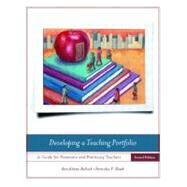
Note: Supplemental materials are not guaranteed with Rental or Used book purchases.
Purchase Benefits
What is included with this book?
| The Teacher Assessment Movement | |
| Portfolio Development | |
| Reflection | |
| The Preservice Teachers Portfolio | |
| Getting a Job | |
| Portfolios for Continuing Licensure | |
| Portfolios for Master Teachers | |
| Digital Portfolios | |
| Reflection Analysis for Chapter 3 | |
| Sample Portfolio Guides for Beginning Teachers to Obtain Licensure: North Carolina and Connecticut | |
| Analysis of Student Work: Assessment | |
| Council for Exceptional Children Standards | |
| Canadian Curriculum Standards: Foundation Statements for Science Literacy | |
| National Council of Teachers of Mathematics K-12 Standards | |
| ISTE Standards | |
| Table of Contents provided by Publisher. All Rights Reserved. |
The New copy of this book will include any supplemental materials advertised. Please check the title of the book to determine if it should include any access cards, study guides, lab manuals, CDs, etc.
The Used, Rental and eBook copies of this book are not guaranteed to include any supplemental materials. Typically, only the book itself is included. This is true even if the title states it includes any access cards, study guides, lab manuals, CDs, etc.